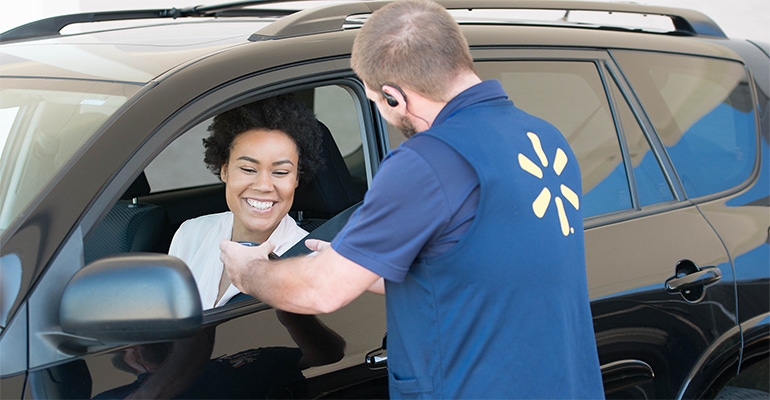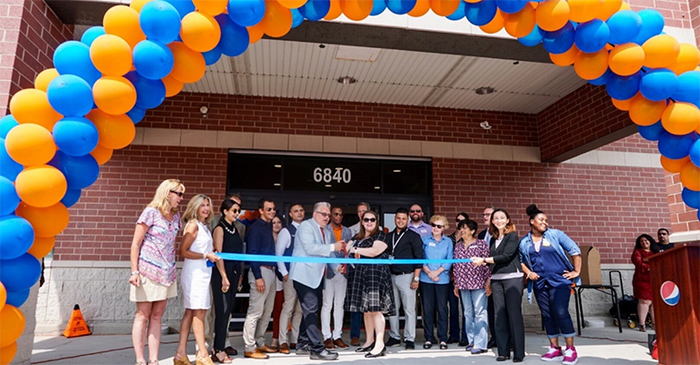Walmart makes a 'point' with pickup
Retail giant to open its biggest grocery pickup/delivery facility

Walmart is set to open its largest stand-alone grocery pickup and delivery center in Lincolnwood, Ill.
Situated on a former Dominick’s supermarket site, the Lincolnwood Walmart Pickup Point will fulfill online orders for groceries, health and wellness products, and daily staples and home essentials like diapers, household cleaners, pet supplies and office supplies.
The 40,000-square-foot facility, located at 6840 N. McCormick Blvd., is slated to go into operation on July 10. Walmart held a grand-opening event yesterday that included a ribbon-cutting with associates and elected officials, tours of the center and giveaways from on-site vendors.
“The Lincolnwood Walmart Pickup Point gives busy customers the ability to shop how, when and where they want, without having to leave their cars or homes,” Store Manager Nicole Olson said in a statement. “Our customers know we have everyday low prices, now we can also save customers precious time.”
Customers order their groceries as usual via the Walmart Grocery app or website — or general merchandise and other products on Walmart.com — and then choose pickup or delivery and select a time. Next, specially trained Walmart personal shoppers pick and pack the order inside the Lincolnwood Pickup Point. Upon arriving at the facility, customers notify Walmart via the app or call a designated number to alert an associate. A personal shopper then loads the order into the customer’s vehicle. For delivery customers, a Walmart delivery partner retrieves their order from the Lincolnwood center and delivers it to their home during the specified time window.
Pickup is available from 8 a.m. to 10 p.m. and delivery from 8 a.m. to 8 p.m. Customers pay one fee: $4.95 for pickup and between $7.95 and $9.95 for delivery, depending on the time of day, Walmart said. To support the launch of the Lincolnwood Pickup Point, the retailer will waive pickup and delivery fees for online orders of $50 or more when shoppers enter the promotional code SHOPFREE at checkout. Customers can use the code as many times as they want for purchases until Sept. 15.
Primarily inventory space, the Lincolnwood Pickup Point building will have no customer access. Signs direct customers driving through the lot to canopied pickup bays, where they park in a designated space to collect their order. Pickup trips and parking spots will be coordinated to avoid congestion.

The location marks Walmart’s first self-standing pickup facility in Illinois. The Bentonville, Ark.-based retailer said that this year it plans to spend $87.5 million on the launch and expansion of new innovations and store remodels in the state, where it operates 186 stores.
“We’re very excited to welcome Walmart’s first Pickup Point in Illinois to our village,” said Lincolnwood Village President Barry Bass. “Walmart’s commitment to bring this new innovative service to the Village of Lincolnwood will create new jobs and generate new revenue for the village, while providing a great new service for our residents.”
Pickup is a pillar of Walmart’s e-commerce fulfillment scheme, and the company has tested various options. For example, Walmart operates a number of stand-alone pickup facilities, including near its Bentonville headquarters and in Metairie, La., and it has piloted 24-hour automated pickup kiosks that measure 20 feet wide by 80 feet long and can hold 30,000 items. The first launched in mid-2017 near Oklahoma City.
More prevalent are in-store Pickup Towers. In April, Walmart said it “soon” planned to roll out 900 more Pickup Towers, which act as large vending machines where customers can collect online orders. Walmart had deployed Pickup Towers to more than 700 stores by the end of 2018 after launching the self-serve concept in 2017.
Currently, about 2,450 of Walmart’s U.S. stores provide free grocery pickup, and 1,000 offer same-day delivery. By the end of 2019, the company plans to have grocery pickup available from 3,100 stores and same-day delivery from 1,600 stores, covering approximately 80% and 50% of the U.S. population, respectively.
About the Author
You May Also Like






